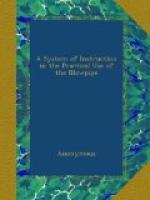By fusion with carbonate of soda, titanic acid is dissolved with effervescence to a clear dark yellow bead, which crystallizes by cooling, whereby so much heat is eliminated, that the bead, at the instant of its crystallization, glows with great brightness. A reduction to a metal cannot, however, be effected. By ignition with a solution of nitrate of cobalt in the oxidation flame, it yields an infusible yellowish-green mass.
(h.) Uranium (U).—This rare metal occurs in the form of protoxide along with other oxides, in the mineral pitch-blende; as peroxide in uranite and uran-mica, associated with phosphoric acid and lime.
In the metallic state it presents the appearance of a dark grey mass, which is infusible, and remains unchanged when under water, or when exposed to dry air, but, when heated in the oxidation flame, it becomes oxidized, with lively sparkling, to a dark green mass, composed of the protoxide and peroxide.
The protoxide of uranium (UO) is black, uncrystalline, or forms a brown powder. When exposed to heat it is converted partially into peroxide, when it has a dark green color.
The peroxide of uranium (U^{2}O^{3}) is of an orange color, while its hydrate is of a fine yellow color, and in the form of a powder. The salts are yellow.
By heating it in the oxidation flame, it acquires a dark green color, and is partly reduced to protoxide. In the reduction flame it presents a black appearance, and is there completely reduced to protoxide.
Borax dissolves it in the oxidation flame to a clear dark yellow bead, which is colorless when cold, if the metal is not present in great quantity. If more of the metal, or peroxide, be added, the bead changes to orange when hot, and light yellow when cold. When heated with the intermittent flame, it requires a large quantity of the peroxide to produce an enamel appearance in the cooled bead.
In the flame of reduction the bead becomes of a dirty green color, being partly reduced to protoxide, and appears, with a certain degree of saturation, black, when heated intermittingly, but never enamelled. The bead appears on charcoal, and with the addition of tin, of a dark green color.
It fuses with microcosmic salt in the oxidation flame to a clear yellow bead, which is greenish-yellow when cold. In the reduction flame it produces a beautiful green bead, which increases when cold.
When fused upon charcoal with the addition of tin, its color is darker. Carbonate of soda does not dissolve it, although with a very small portion of soda it gives indications of fusion, but with still more of the soda it forms a yellow, or light-brown mass, which is absorbed by the charcoal, but it is not reduced to the metallic state.
(i.) Vanadium (V).—This very rare mineral is found in small quantity in iron-ores, in Sweden, and as vanadic acid in a few rare minerals. The metal presents the appearance of an iron-grey powder, and sometimes that of a silver-white mass. It is not oxidized either by air or water, and is infusible.




